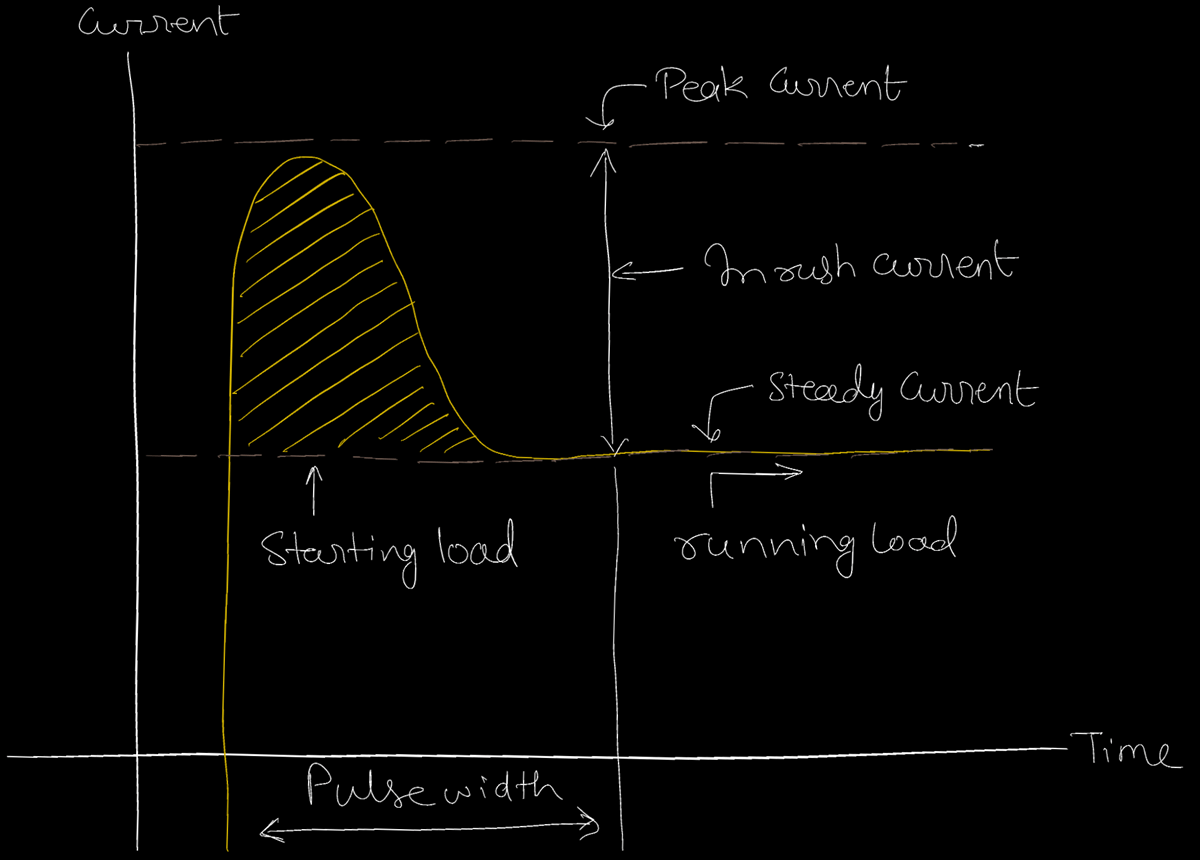Inrush current, also known as ‘inrush current surge’ or ‘switch-on surge’, refers to the temporary surge of electrical current that occurs when a device or electrical equipment is first turned on. This term is particularly relevant in applications like heavy power systems, transformers, motors, and electronic devices.

Why is there inrush current, can’t we do some soft starters to avoid this?
Actually, it is not always feasible to use soft starters and in heavy equipments as inrush current cannot be avoided completely. But where the load is low like ceiling fans we have BLDC motors that use soft start mechanism.
Let’s see causes, effects, and mitigation strategies of inrush current in an electrical appliance or machine.
Causes of inrush current.
1. Capacitive and inductive elements.
Inrush current is often associated with capacitive and inductive elements within electrical circuits.
Capacitors tend to draw a high current during the initial charging phase, while inductive loads, such as transformers and motors, exhibit a surge due to the magnetic field buildup.
2. Power transformer energization.
When a power transformer is energized, it experiences inrush current due to the magnetization of its core.
This initial surge is typically several times (it can be 5 to 25 times, and it may flow for several cycles) higher than the normal operating current and can stress the transformer windings and associated circuitry.
3. Motor starting.
Electric motors, especially those with large horsepower ratings, can generate significant inrush current when starting or start button is kicked-in. The high initial current is necessary to overcome the inertia of the motor and initiate rotation.
4. Heaters and filaments.
Electric heaters and filaments requires high current when they are turned on for the first time. As it takes a lot of energy to heat down filaments, the system may be inrush current for the initial few seconds or minutes.
Effects of inrush current.
1. Voltage drops.
Inrush current can lead to a transient voltage drop in the electrical system. This can affect the performance of sensitive electronic equipment, disrupt communication systems, and potentially cause malfunctions in industrial processes.
2. Electromagnetic Interference (EMI).
The rapid and transient nature of inrush current can produce electromagnetic interference, affecting nearby electronic devices and communication systems. This interference may result in signal distortion, data corruption, or even complete failure of electronic equipment.
3. Thermal stress.
Inrush current can cause thermal stress on electrical components, particularly conductors and transformers. The sudden increase in current generates heat, which can impact the insulation and overall integrity of the equipment.
4. Voltage flicker.
In applications where inrush current is significant, voltage flicker may occur, causing fluctuations in the electrical supply. This can be problematic for sensitive equipment and may lead to operational issues in certain applications.
Mitigation strategies to avoid inrush current.
1. Soft starters.
Implementing soft starters in motor-driven systems can help reduce inrush current by gradually ramping up the voltage during the motor start-up process. This controlled acceleration minimizes the stress on the electrical components and mitigates the effects of inrush current.
2. Inrush Current Limiters (ICLs).
Inrush current limiters are devices designed to restrict the initial surge of current when a device is powered on. These devices, often based on resistive or inductive elements, provide a controlled and gradual increase in current, preventing sudden spikes.
3. Transformer design considerations.
Transformer manufacturers often incorporate design features to minimize inrush current, such as using low-flux density cores, adding damping resistors, or employing special winding configurations. Proper transformer design can significantly reduce the impact of inrush current during energization.
4. Voltage regulation.
Maintaining stable voltage levels in the electrical system helps mitigate the effects of inrush current. Voltage regulators and compensators can be employed to ensure that voltage variations are within acceptable limits, minimizing the impact on connected equipment.
Conclusion.
Inrush current is a transient occurrence that demands careful consideration in the design and operation of electrical systems. Understanding the causes, effects, and mitigation strategies is crucial for ensuring the reliability and efficiency of power distribution networks, industrial processes, and electronic devices.
By implementing appropriate measures such as soft starters, inrush current limiters, and thoughtful transformer design, engineers and operators can effectively manage inrush current and safeguard the integrity of electrical systems.
Leave a Reply